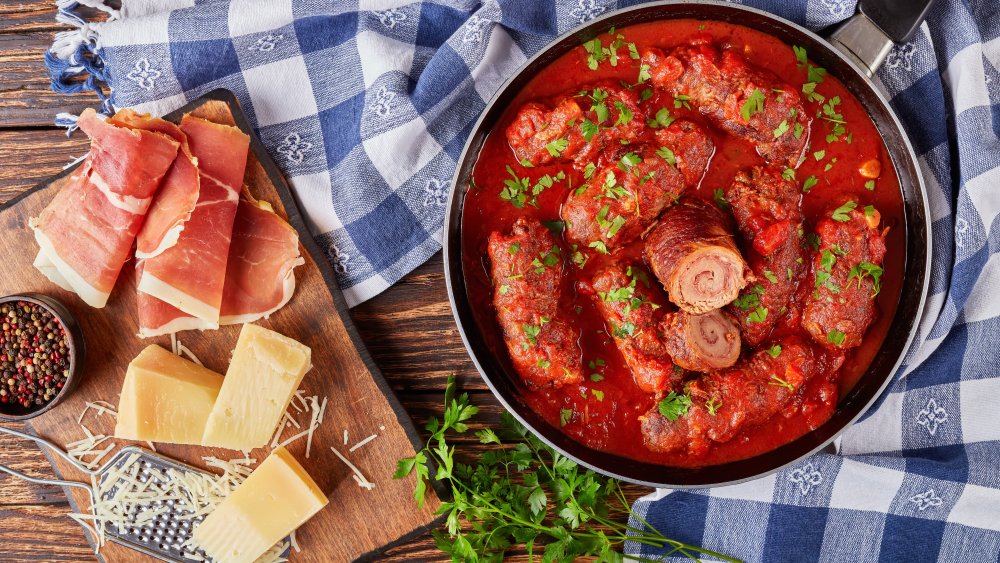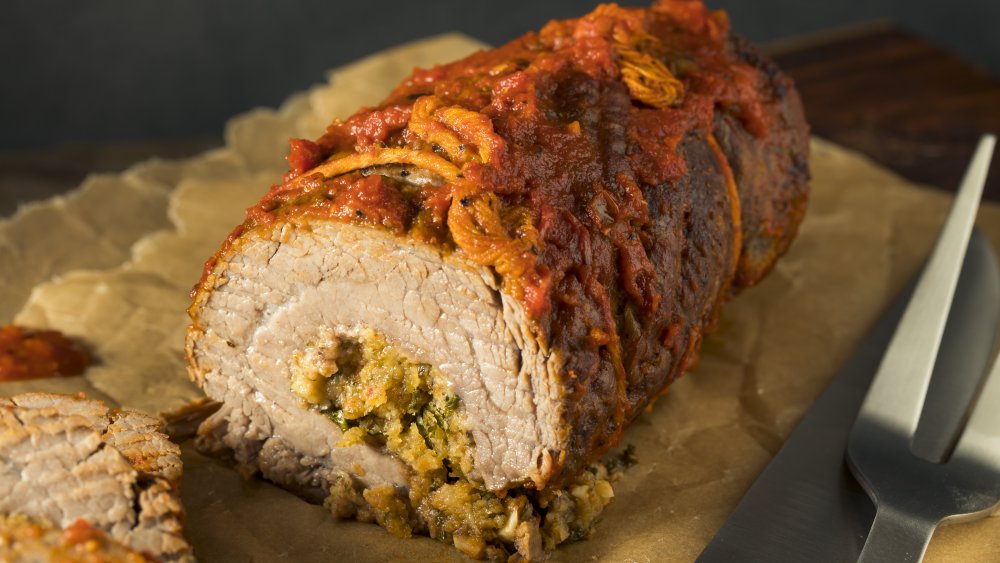The Untold Truth Of Braciole
Braciole (pronounced "braJOLE"), the plural form of the singular "braciola," is a classic Southern Italian, and particularly, Sicilian dish introduced to the U.S. by early 20th century immigrants. Made with various meats, cheeses and seasonings and cooked in tomato sauce, for many Italian-Americans, braciole became an essential part of a traditional Sunday dinner.
Although the word "braciole" literally translates to "chops," when it comes to Italian-American cooking, braciole refers to thin meats rolled around a "stuffing" of ingredients such as Parmesan or Romano cheeses, bread crumbs, cured meats, and various seasonings, then braised in a hearty tomato sauce.Braciole utilizes thinly sliced beef, or less commonly, veal, pork, or chicken. In Sicily, fish is even sometimes used in braciole, according to Slow Burning Passion. Interestingly, poorer Italians used whatever meat was on hand, even goat. When they came to America, where beef was more readily available, they adopted it for braciole, says The Philadelphia Inquirer.
Making braciole starts with pounding the meat with a mallet, which makes it more pliable for rolling and results in a more tender finished product. A large braciole, or in Sicily, "farsumagru," (via All Things Sicilian and More), is similar to a roulade, using an entire cut of meat, such as a flank steak or top round, rolled around the stuffing, cooked, then sliced into individual servings. More commonly, braciole refers to small cuts of meat rolled with the stuffing ingredients to create individual servings. In Sicily, these are called "bracioli," or "braciulini" (via All things Sicilian and More).
How to make braciole
To make braciole, once the meat is pounded, the fillings are placed on in layers. The meat is then rolled and secured with toothpicks or butcher's string, seared, and simmered for several hours in tomato sauce until it is very tender.
Because the process is time-consuming, you won't often find it in Italian restaurant (via NJ.com). For this same reason, braciole is often a special-occasion dish, reserved for Christmas or other holidays (via Slow Burning Passion). The site also notes that the "right" way to make braciole is the way your "nonna" made it. In other words, there are many family recipes and strong opinions about braciole. The most common fillings for this dish are fresh herbs and cheese, but ingredients can include raisins and nuts, and other meats.
From a Chef's Kitchen offers a traditional recipe as well as a version with spinach, pine nuts, and raisins. Giada De Laurentiis makes a large roulade-type braciole with flank steak and traditional filling ingredients including Pecorino Romano and provolone cheeses, Italian-style bread crumbs, garlic, and fresh parsley. Martha Stewart offers a recipe for individual servings of braciole stuffed with green olives and raisins. Braciole can be served as a main course, or, more commonly, with pasta. Polenta is another delicious way to serve braciole (via Linda's Italian Table).
If you have the patience to spend the day by the stove and a love of succulent, fall-apart-in-your-mouth beef dishes, this Sunday might be a great time to try your hand.

